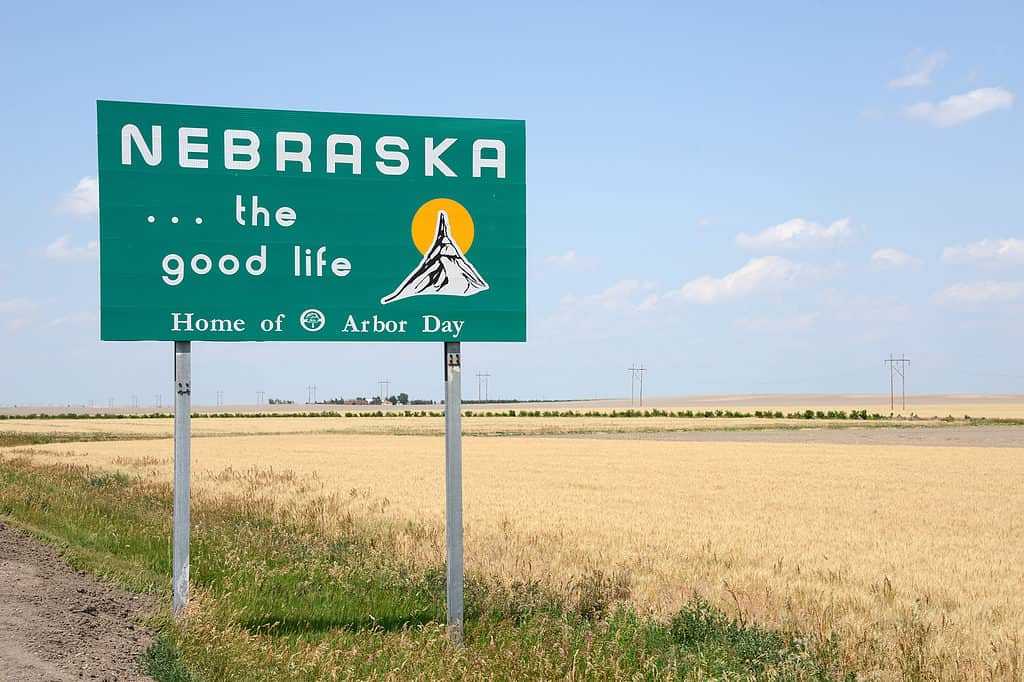
Nebraska has at least 30 different types of snakes, of which only four are venomous.
©Michael Kaercher/Shutterstock.com
There are at least 30 different types of snakes that live in Nebraska. However, only four of these snakes are venomous and potentially dangerous: the eastern copperhead snake and three different species of rattlesnake. As terrifying as these snakes may seem at first, they are usually quite shy and try to avoid humans as much as possible. Most rattlesnakes will only strike if they are threatened or harassed.
Many people are scared of snakes and believe they should be eradicated. However, snakes are important in Nebraska. They help to keep the ecosystem balanced by keeping rodent populations in check. Let’s look at the three different types of rattlesnakes in Nebraska, and some of the nonvenomous snakes that are often mistaken for rattlesnakes.

1. Timber Rattlesnake

One of the United States’ most venomous rattlesnakes is the timber rattlesnake.
©Frode Jacobsen/Shutterstock.com
| Timber Rattlesnake | |
|---|---|
| Range | Extreme southeastern corner of Nebraska |
| Length | 44-60 inches |
The timber rattlesnake lives in the extreme southeast corner of Nebraska, usually in woodland or rocky areas and along streams. Timber rattlesnakes are a threatened species in Nebraska and are listed as a species in need of conservation. The timber rattlesnake is also sometimes called the banded rattlesnake, velvet-tail rattlesnake, velvet rattler, or the canebrake rattlesnake.
Timber rattlesnakes have dark V-shaped marks along the length of their gold, tan, light brown, or gray bodies. The timber rattlesnakes in Nebraska also have an orange or rust-colored stripe that runs down the middle of their backs. This snake is 44-60 inches long with a black tail and a light-colored rattle.
The timber rattlesnake does not jump to defense quickly, choosing instead to blend into its surroundings or to slither away silently. However, there is a lot of venom injected into this snake’s bite, making it an extremely dangerous rattlesnake. Timber rattlesnakes mostly eat rodents and have been observed climbing trees that are nearly 80 feet tall.
2. Prairie rattlesnake
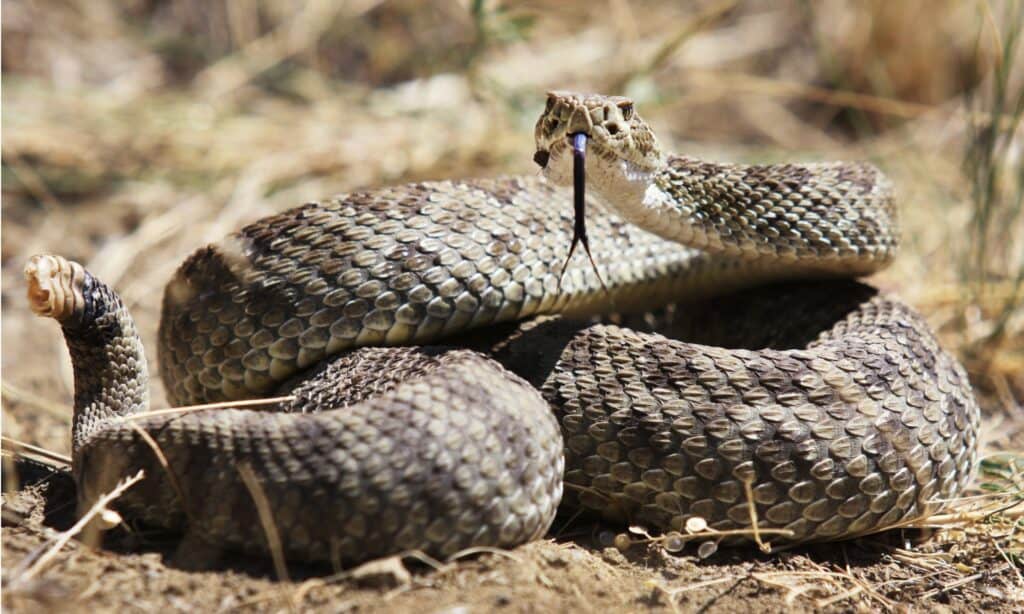
The nonaggressive prairie rattlesnake may be dangerous, but it will not randomly attack humans.
©iStock.com/HRossD
| Prairie Rattlesnake | |
|---|---|
| Range | Western half of Nebraska |
| Length | 35-45 inches |
The prairie rattlesnake lives in the western half of Nebraska. This snake gets its name from living in prairies and grasslands in the Great Plains of North America. It has a very large range, living not only in the United States but in southwestern Canada and northern Mexico as well.
Prairie rattlesnakes are 35-45 inches long and are olive-green, gray, or light brown in color with dark blotches along the middle of their backs. Sometimes they will have dark rings at the end of their tail as well. These colors and patterns help them to blend in with the rocks and protect them from predators. Prairie rattlesnakes often live near prairie dog colonies. They mostly eat small mammals like rabbits, prairie dogs, and other rodents. These snakes often rest in vacated prairie dog tunnels, burrows, caves, and rock crevices.
3. Western Massasauga
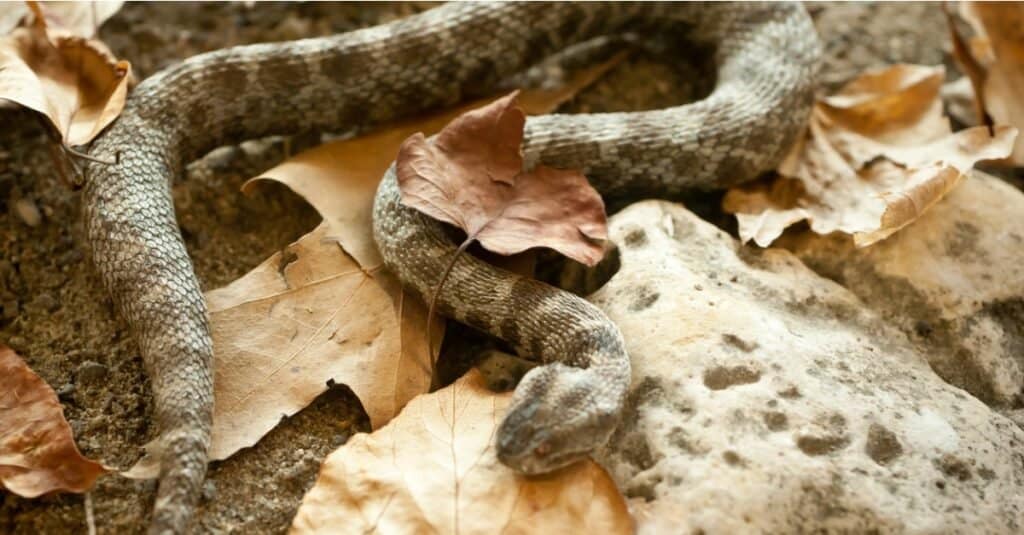
The western massasauga is paler than the desert massasauga, although the two subspecies look similar.
©iStock.com/Westhoff
| Western Massasauga | |
|---|---|
| Range | Southeastern corner of Nebraska |
| Length | 18-26 inches |
The western massasauga is a rattlesnake that lives in the very southeastern corner of Nebraska. Along it usually prefers prairies and grasslands, this snake is also called a “swamp rattler” in Nebraska because it is often found in wet or marsh-like areas there. The Nebraska Game and Parks Commission lists the western massasaugas as an at-risk and threatened species, and it is protected by state laws. This snake is cornered in the southwest of Nebraska due to a decrease in tallgrass prairie. It also faces other risks like predation, loss of habitat, habitat alteration, cattle grazing, road mortality, and illegal harassment by humans.
The western massasauga is a small to medium-sized snake, growing between 18-26 inches long in Nebraska. Its body is usually gray or light brown in color, with dark spots or blotches along its back and sides. Its belly is usually a cream color with lateral blotches as well. There is a dark stripe painted along both sides of its face from its head to the back of its head. The western massasauga is a subspecies of the massasauga rattlesnake, bigger than the Desert Massasauga but smaller than the Eastern Massasauga.
Rattlesnake Look-a-Likes In Nebraska
While there are only three types of rattlesnakes in Nebraska, there are a few nonvenomous snakes that look like rattlesnakes—except of course, they don’t have a rattle at the end of their tails. Check out a few of the rattlesnake “look-a-likes” living in Nebraska.
Prairie Kingsnake

Docile prairie kingsnakes are nonvenomous and secretive.
©Matt Jeppson/Shutterstock.com
| Prairie Kingsnake | |
|---|---|
| Range | Southeastern corner of Nebraska |
| Length | 32-46 inches |
Prairie kingsnakes live in the southeast corner of Nebraska. They are usually light brown, red-brown, light gray, or olive green, with dark square-shaped blotches running down their backs. One of their most distinctive features is the dark V-shaped pattern on the top of their head. Prairie kingsnakes grow to be 32-46 inches long, and like their name, they are often found in prairie-type areas. Although their colors and patterns look a lot like a rattlesnake, these snakes don’t have a rattle and their heads are much smaller. The prairie king snake is quite shy and usually hides under rocks. If it feels threatened it twitches its tail, and if it happens to be hiding near dry leaves, this can make it sound a bit like a rattlesnake.
Bullsnake

When threatened, the bullsnake rears up in an S-shape, hisses, and vibrates its tail.
©GoodFocused/Shutterstock.com
| Bullsnake | |
|---|---|
| Range | All of Nebraska |
| Length | 40-70 inches |
Bullsnakes live all throughout Nebraska and look like rattlesnakes from a distance. Their heads are shaped like a spearhead, similar to the triangle-shaped head of a rattlesnake. However, the bullsnake’s head is thinner and more streamlined than a rattlesnake’s. This unique head-shape helps them to tunnel into the ground to reach their prey. Bullsnakes also mimic rattlesnakes when they feel threatened by hissing loudly and twitching their tails. This snake is usually light brown or yellowish in color, with brown, dark brown, red-brown, or black blotches running down the length of its body. Bullsnakes in the eastern half of Nebraska are often darker than the bullsnakes in the western half. These are the largest snakes in Nebraska, measuring 40-70 inches long.
Western Hognose Snake

The western hognose snake has a thick body and is slightly smaller than the eastern hognose snake.
©Amanda Guercio/Shutterstock.com
| Western Hognose Snake | |
|---|---|
| Range | Western two-thirds of Nebraska |
| Length | 15-20 inches |
The western hognose snake lives in the western two-thirds of Nebraska. These snakes are smaller, and around 15-20 inches long. They come in various shades of brown with dark blotches running along the length of their bodies. These colors and patterns sometimes make them look like a rattlesnake from a distance. However, the western hognose snake has a much smaller head and does not have a rattle. Additionally, this snake has an upturned nose, which makes its snout resemble that of a pig or hog. This upturned snout acts like a tiny shovel, helping the western hognose snake to dig through the soil. Western hognose snakes are not dangerous to humans. When this snake feels threatened, it will attempt to play dead, flatten its head, or puff up.
Western Fox Snake
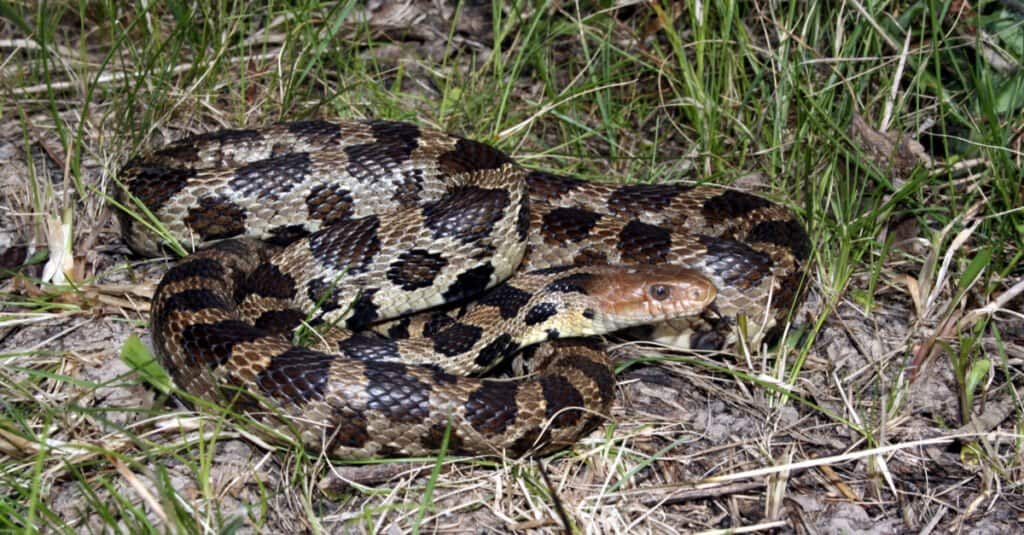
When threatened, the western fox snake emits a smelly musk similar to the odor of a red fox.
©Psychotic Nature/Shutterstock.com
| Western Fox Snake | |
|---|---|
| Range | Northeastern Nebraska |
| Length | 36-50 inches |
The western fox snake lives in northeast Nebraska. These snakes grow to be 36-50 inches long and are usually various shades of brown, sometimes mixed with yellow or red tones. They have dark blotches running down their backs. Like rattlesnakes, western fox snakes shake their tails quite a bit. Unfortunately, people often mistake these snakes for Massasauga rattlesnakes and harm or kill them, even though western fox snakes are nonvenomous and harmless to humans. If you come across one and are not sure if it’s a rattlesnake or a western fox snake, check to see if it has a rattle—if it doesn’t, it’s not a rattlesnake. In addition, western fox snakes have very small heads and tiny round eyes, while rattlesnakes have large triangle-shaped heads and vertical pupils.
| Rattlesnakes in NB | Look-Alikes in NB |
|---|---|
| Timber | Prairie Kingsnake |
| Prairie | Bullsnake |
| Western Massasauga | Western Hognose Snake |
| Western Fox Snake |
Summary Of The 3 Types of Rattlesnakes in Nebraska
| Rank | Snakes |
|---|---|
| 1 | Timber Rattlesnake |
| 2 | Prairie Rattlesnake |
| 3 | Western Massasauga |
Other Reptiles Found In Nebraska
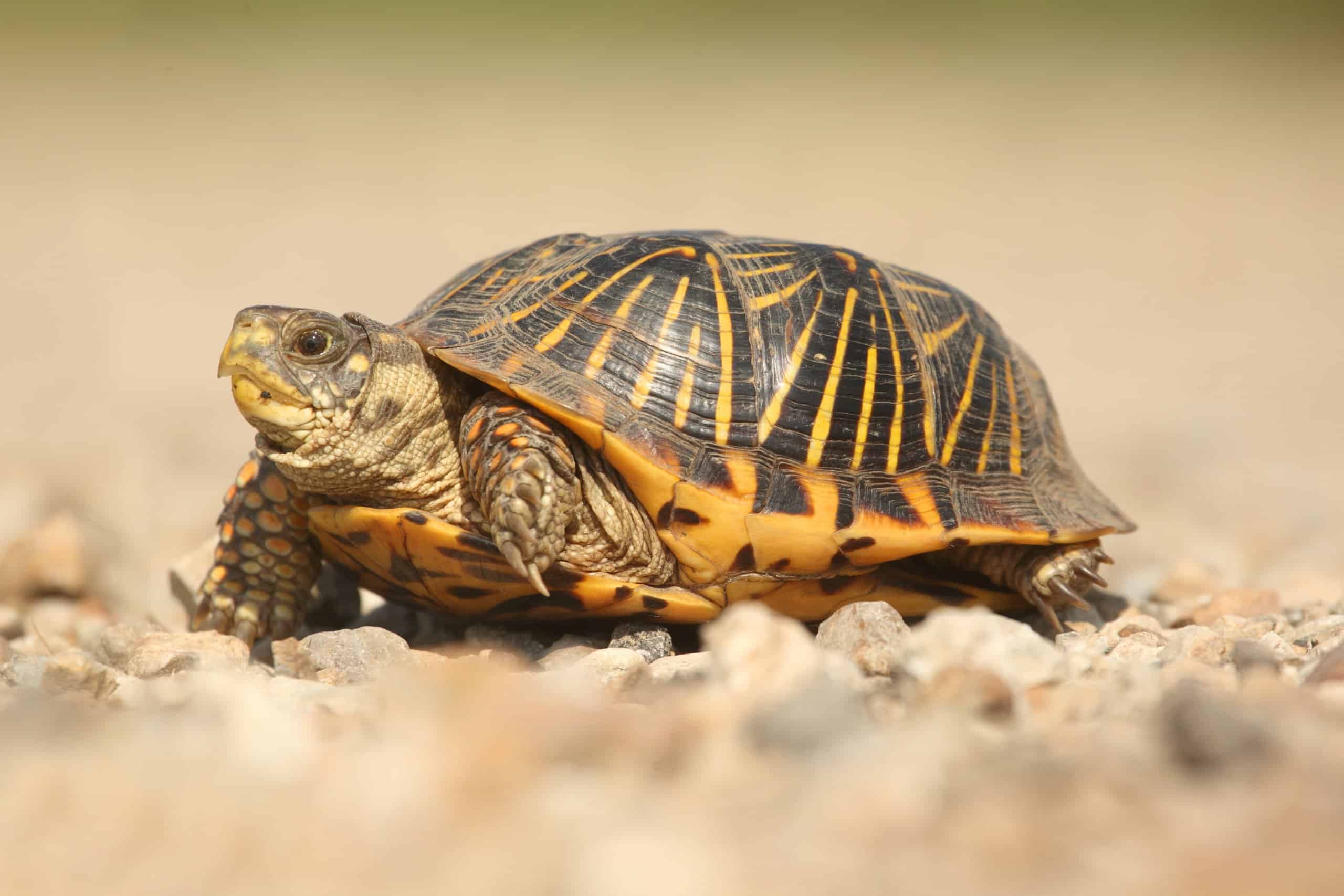
Ornate box turtles are a subspecies of the western box turtle.
©Steve Byland/Shutterstock.com
The top reptile in Nebraska is the ornate box turtle. As the state’s only native land turtle, it was recently proclaimed the official reptile by the governor and is one of 48 different species of reptiles that call this state home. Found in grasslands throughout most of Nebraska, the ornate box turtle has a single hinge shell and to protect itself from predators can almost enclose itself entirely.
Another native species is the prairie lizard, found in the western part of the state, known primarily as a ground-dwelling lizard, it can reach lengths of just over three inches. Sometimes referred to as the eastern fence lizard, they rely on their speed to evade predators but if captured by their tails, this appendage can break off, allowing them to make a quick getaway, and the tail will eventually grow back.
The photo featured at the top of this post is ©
Discover the "Monster" Snake 5X Bigger than an Anaconda
Every day A-Z Animals sends out some of the most incredible facts in the world from our free newsletter. Want to discover the 10 most beautiful snakes in the world, a "snake island" where you're never more than 3 feet from danger, or a "monster" snake 5X larger than an anaconda? Then sign up right now and you'll start receiving our daily newsletter absolutely free.
Thank you for reading! Have some feedback for us? Contact the AZ Animals editorial team.






